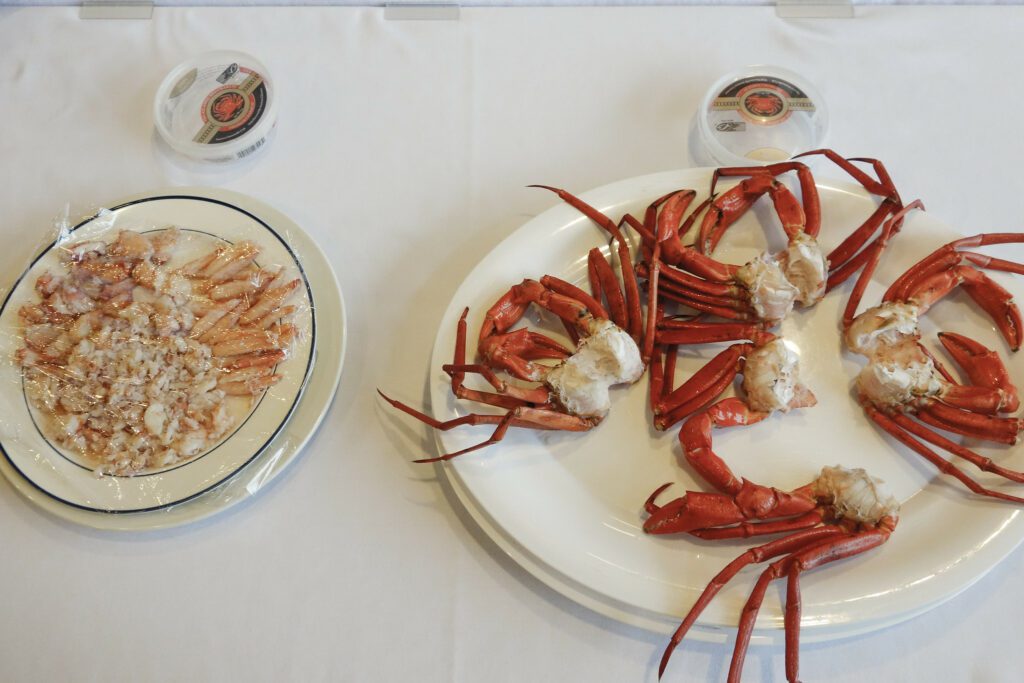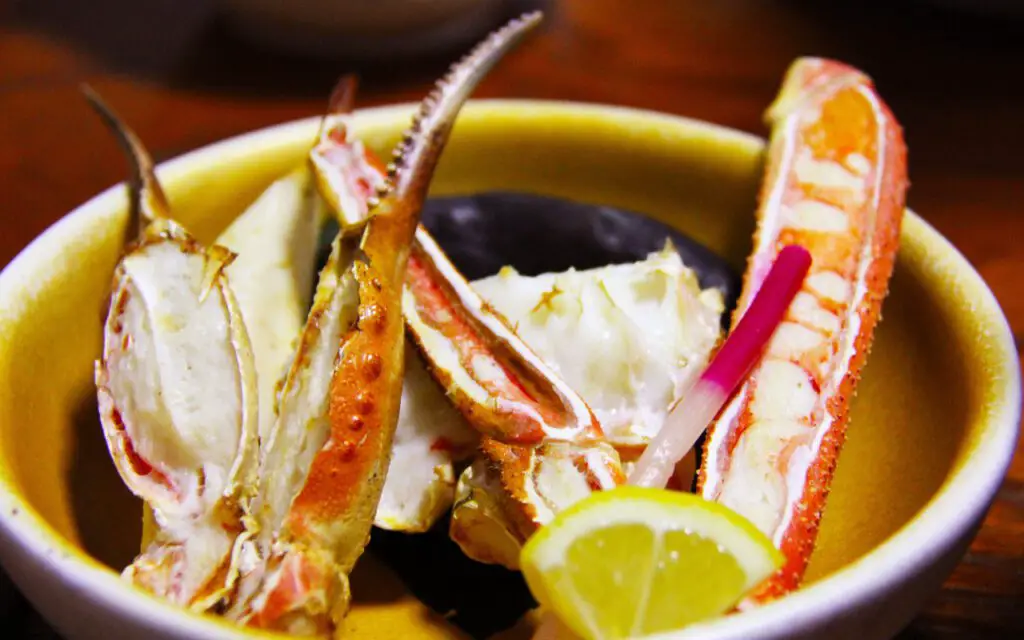When it comes to feeding your dog, choosing the right food can play a significant role in their health and well-being.
Many owners may be curious about introducing seafood into their dog’s diet, and crab is a popular delicacy that many humans enjoy.
However, is crab a safe and healthy option for dogs to eat?
In this blog post, we’ll explore the nutritional value of crab and whether or not it’s a good idea to feed it to your furry friend. We’ll also discuss the potential risks and benefits of including crab in your dog’s diet.
Can Dogs Eat Crab?

Yes, dogs can eat cooked and shelled crab in moderation. Crab meat is a lean protein that is full of essential minerals like zinc, phosphorus, and magnesium.
It also contains omega-3 fatty acids which are beneficial for your pup’s health.
Dogs can eat any type of cooked crab, such as blue crab, king crab, snow crab, and Dungeness crab.
However, it is important to ensure that the crab meat is cooked thoroughly to avoid any potential contamination with bacteria.
Additionally, it is best to avoid feeding your dog raw crabs or canned crabs as the salt content in these products may be too high for your pup’s sensitive stomach.
However, it is important to note that there is a risk of an allergic reaction to crab meat and it should be boiled before feeding it to your dog.
Additionally, watch out for signs of stomach upset after giving your pet new food.
See also: Top 10 Safe Seafood Options For Dogs To Eat
Can Dogs Eat Crab
How Much Crab Can Dogs Eat?

Generally, it is recommended that dogs only eat about one ounce of cooked and de-shelled crab meat per 10 pounds of body weight. For example, a 20-pound dog should only be given two ounces of cooked and de-shelled crab meat.
It is important to note that while crabs are not toxic to dogs, they do contain high levels of sodium and cholesterol which can be fattening for your pup if eaten in large amounts.
Therefore, it is best to limit the amount of crab your dog eats and always consult with your veterinarian before feeding any new food to your pet.
Crab Feeding Chart According To Size
| Food | Size | Portion |
|---|---|---|
| Crab | Toy dogs | 1 ounce |
| Crab | Small dogs | 2 ounce |
| Crab | Medium dogs | 3-5 ounces |
| Crab | Large Dogs | 5-9 ounces |
Crab Feeding Chart According To Age
| Food | Age | Portion |
|---|---|---|
| Crab | 0 – 6 months | Don’t feed |
| Crab | 6 – 12 months | 2 ounces |
| Crab | 12 – 24 months | 4 ounces |
| Crab | 24+ months | 5-9 ounces |
Can Dogs Eat Crab
How Often Can Dogs Eat Crab
The frequency with which dogs can eat crab depends on their size and activity level. Smaller and more active dogs can typically consume crab meat more frequently than larger and less active breeds.
Generally, it is recommended that dogs have no more than 1 ounce of cooked and de-shelled crab meat per 10 pounds of body weight per week.
For example, a 20-pound dog can safely eat 2 ounces of cooked and de-shelled crab meat per week. It is important to remember to consult with your veterinarian before introducing any new food into your pup’s diet.
Health Benefits of Crab To Dogs
- Low-Calorie Content. Crab meat is low in calorie content, making it a great choice for dogs trying to maintain their weight. A single serving of crab contains about 40 calories per serving.
- Protein Rich. Crab is an excellent source of lean protein for dogs. This lean protein helps to build and maintain muscle mass, keeping your pup healthy and strong.
- Omega 3 Fatty Acids. Crab is rich in omega-3 fatty acids which are essential nutrients that help to reduce inflammation and aid in brain development.
- Vitamins & Minerals. Crab meat is loaded with vitamins and minerals such as B vitamins, Vitamin D, phosphorus, iron, and zinc. These vitamins and minerals can help keep your pup’s fur soft and shiny and support a healthy immune system.
- Healthy Fats. The high levels of healthy monounsaturated fats in crab make it a great source of energy for active pups.
Potential Risks of Feeding Crab To Dogs
- High Sodium Content. The high sodium content in crab meat can lead to increased thirst and urination, as well as stomach upset. To reduce the risk of these potential side effects, be sure to give your pup only de-shelled, cooked, and drained crab meat.
- Choking Hazard. Crab shells pose a choking hazard for dogs of all sizes, so it’s important to remove the shell before feeding any cooked crab meat to your dog.
- Allergic Reactions. Some dogs may have an allergic reaction to the proteins found in crab meat. These reactions can cause diarrhea and vomiting and it is best to consult with a veterinarian before introducing any new food into your pup’s diet.
- Increases Risk of Weight Gain. Too much crab, like any other food, can lead to weight gain. Be mindful of portion size when feeding your pup any form of seafood.
Nutritional Benefits of Crab For Dogs
| Crab Nutrition Facts per 100 grams | % DV * |
|---|---|
| Calories | 74 |
| Total Fat | 0.9 g |
| Cholesterol | 114 mg |
| Sugar | 0 g |
| Glycemic Index | 5 |
| Sodium | 466 mg |
| Carbs | 0.03 g |
| Protein | 15.4 g |
| Vitamin D | 0 % |
| Calcium | 107 mg |
| Iron | 0.6 mg |
| Potassium | 305.6 mg |
Can Dogs Eat Crab
Are Dogs Sensitive To Crabs?
Dogs can be sensitive to crabs and other types of seafood, just like humans. Symptoms of a crab allergy in dogs may include itching, redness or hives, vomiting, or diarrhea.
If you suspect your pup is having an allergic reaction to crabs, it’s best to contact your veterinarian right away. Diagnosing a crab allergy in your dog can be difficult and will require a few tests from the vet.
It’s also important to note that some breeds of dogs are naturally more sensitive to seafood than others. Be sure to research your breed before introducing any kind of new food into their diet.
How To Prepare Crab For Dogs
- Boil. Boiling is a great option for preparing crab for Fido. Start by boiling water in a large pot and adding in the cleaned de-shelled crab meat. Let it cook until the meat turns an orangey-red color.
- Bake. Preheat your oven to 350 degrees Fahrenheit and put the cleaned, de-shelled crab into a baking dish. Drizzle with some melted butter or olive oil, if desired, and bake for about 20 minutes until cooked through.
- Steam. An easy way to prepare steamed crab for your pup is by putting the cleaned, de-shelled crab in a steamer basket set over a pot with boiling water. Cover and steam for 10 to 12 minutes or until cooked through.
How Fast Will Dogs Digest Crab
Dogs can digest crab relatively quickly compared to some other types of food. The average time it takes for a dog to digest a meal is about 8 to 10 hours.
However, the type and amount of food can affect digestion time; for example, it would take longer for a dog to digest a heavy meal than one that is light.
If your pup’s diet consists mostly of fresh, high-quality crab meat, their digestive system should be able to process it in around 8-10 hours.
FAQs
Can dogs eat crab sticks?
Yes, dogs can eat crab sticks in moderation. While some crabs are a good source of healthy protein and minerals, many of the ingredients found in crab sticks aren’t very nutritious for your pup. Check the label to make sure that the crab stick does not contain any added sugar, MSG, onions, garlic, or other ingredients which could be toxic for dogs.
Can dogs eat crab shells?
No, dogs should not eat crab shells. While shellfish can provide some nutritional benefits for your pup, the hard texture of crab shells can be a choking hazard and may cause digestive issues like indigestion or vomiting. Additionally, the shell could damage their teeth as they try to break it down.
Can dogs eat crab cakes?
No, dogs should not eat crab cakes. These snacks are often made with ingredients like white bread and butter which can be difficult for dogs to digest.
Can dogs eat crab rangoon?
No, dogs should not eat crab rangoon. Crab rangoon contains ingredients that are unhealthy for dogs and may even be fatal if ingested. The wrapper itself is a choking hazard and the cream cheese inside can give your pup an upset stomach or may even cause pancreatitis in some cases.
Can dogs eat crab apples?
Yes, dogs can eat crab apples in moderation. Just make sure to remove the core and seeds before feeding them to your pup since these parts of the apple are not safe for them to consume.
Can dogs eat crab legs shells?
No, dogs should not eat crab leg shells. Crab shells can be a choking hazard for your pet and could cause an intestinal blockage if the pieces are too large.
Can dogs eat crab salad?
No, dogs should not eat crab salad. While crabs are a safe seafood option for humans to consume, they may contain too much salt, fat, and other spices that can be dangerous for dogs in large amounts. Additionally, many crab salads contain onions or garlic which are toxic to pets.
In Conclusion
No, dogs should not eat crab salad. While crabs are a safe seafood option for humans to consume, they may contain too much salt, fat, and other spices that can be dangerous for dogs in large amounts.
Additionally, many crab salads contain onions or garlic which are toxic to pets.
Related articles:
- Can Dogs Eat Raw or Cooked Salmon?
- Can Dogs Eat Shrimp? Shell-Yeah!
- Can Dogs Eat Tuna? From The Sea To The Bowl
- Can Dogs Eat Cod? A Nutritious Treat For Your Pooch
- Can Dogs Eat Lobster? A Gourmet Treat For Your Pooch
- Can Dogs Eat Mussels? To Mussel or Not To Mussel
- Can Dogs Eat Squid? Squid-tastic Addition To Your Dog’s Diet
- Can Dogs Eat Scallops? Paws Up or Paws Down?
- Can Dogs Eat Sardines? Tiny Fish, Big Impact




Leave a Reply